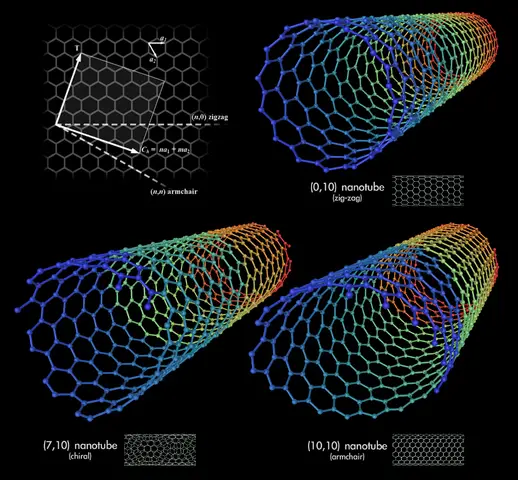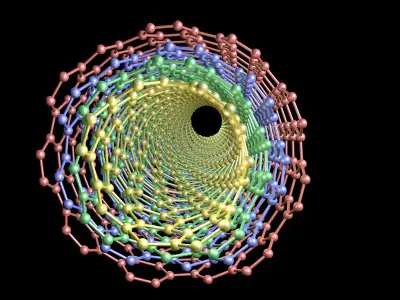Carbon Nanotubes
Properties, Modifications and Use in Atomic Force Microscopy
While carbon nanotubes are complex structures, one can easily come to understand them and their many functions when broken down into individual components. To start, carbon is an organic molecule that plays a role in some life processes but in different arrangements at the atomic level, it can also be detrimental to one's health.
A nanotube is simply one of the various forms of carbon, which has a tubular shape and is only measurable at the nano level. An object measured on the nano scale is extremely tiny, as it measures no more than one ten-thousandth of a single hair. Therefore, a carbon nanotube is a microscopic tube made of carbon molecules in a hexagon formation, and if you need a visual, just think of a rolled up chain-link fence.
Properties
Just as carbon has different molecular structures and arrangements, so do carbon nanotubes. Each type of carbon nanotube has a specific purpose, as some bind to certain cells while others serve as engineering tools. In comparison to other elements, building materials and even different types of carbon, the nanotube form is the strongest, has the highest specific density, electrical and thermal conductivity, and is the most resistant to tension.
One of the most important property’s of a nanotube is its varying thickness, length, layers and helicity, as these characteristics establish the structure, and therefore, the electrical traits of the molecule.
The electrical component is partially responsible for determining whether the carbon acts as a semiconductor or a metal, an important difference when it comes to applying this material to scientific or technological advancements.
Image from Nanopaprika.eu
Modifications
Although carbon nanotubes have naturally incredible properties, the concept of altering the molecules’ natural state did not escape scientists and this thought lead to the development of additional applications.
The most significant alteration to date consists of modifying the length of the carbon nanotube, which has the potential to cover miles but presently, the longest strand achieved is only between one and two centimeters.
If laboratory technicians could manipulate the nanotubes to reach their potential length, it would result in an extremely light but incredibly strong material that engineers could use to build future structures.
Atomic Force Microscopy
In researching the various forms, shapes and potential of carbon nanotubes, scientists discovered that they could grow these very thin and strong molecules by using ethylene and iron in a process known as chemical vapor deposition.
This process results in a tip that one can apply to the end of an atomic force microscopy probe, which is a fancy way of saying an imaging laser that relies on force to collect accurate data. The more force that exists between the subject matter surface and the tip of the probe, the better will be the resulting image.
The reason carbon nanotubes are important in this type of testing is because they offer a smaller, non-invasive probe tip that can last longer and provide more accurate, detailed images of the subject matter. When researching material at an atomic level or smaller, clarity, color and intensity of the image matter, as it enables scientists to see material previously unknown and study it in depth.
For instance, scientists know that specific pathogens, referred to as amyloid-B fibrils and globular amyloid-B oligomers, are present in people with Alzheimer’s disease, but did not have the tools to examine the structures of such small material.
The discovery of carbon nanotubes, as well as the knowledge that their structure is modifiable, provided researchers with the ability to see and study the arrangement of globular amyloid-B oligomers.
It is now public knowledge that this type of amyloid has an “annular structure with four-fold internal symmetry and a central pore-like depression.” This discovery is significant because it may help in determining the specific component of amyloid-B that causes the degeneration associated with Alzheimer’s, thus giving scientists the information necessary to eventually come up with a cure.
Scientists are also applying carbon nanotubes to atomic force microscopy probes when researching DNA, another area in which these tiny molecules are leading to advancements. However, for scientists to move forward, the carbon nanotube tips currently in use require additional modification, as the desire to lengthen this element is not beneficial in all applications.
Some studies suggest that the length of the carbon nanotubes, when used as tips, must decrease because the longer tips are unstable and produce an image of lower quality.
Applications
The discovery of the carbon nanotube occurred over 20 years ago, and since that time the exploration of this new pathway has continuously resulted in progress, as well as a high-level of interest in mechanical and biological applications.
The excitement of this new field quickly generated a number of applications, all of which are undergoing further study and improvements. One of the major applications of carbon nanotubes is in cancer treatment, as the molecule could possibly assist in two very different ways.
First, a carbon nanotube has the ability to attach to a chicken antibody, the latter of which happens to like proteins made by one of the specific cells responsible for breast cancer. Once attached to the antibody connected to the protein, the nanotube absorbs light from an externally administered laser and essentially fries the cancerous protein without damaging the surrounding tissue, a damaging side effect of current cancer treatments.
In another application, nanotubes are responsible for identifying proteins associated with oral cancer and can do so in just one hour.
The ability to heal bones is another trait possessed by the carbon nanotube, as it attracts hydroxyapatite, a collection of calcium salts that make up part of the material found between bone cells. By placing the nanotube at the repair site, it signals the bone cells to come over and create new bone, a technique that has the potential to treat people with various forms of osteopathy.
As for technological uses, nanotubes are creating lighter, thinner televisions with better picture quality and if you ever find yourself walking around with a rolled-up media device in your pocket, you can thank carbon nanotubes for such convenience.
Manufacturers of bulletproof vests are looking to replace Kevlar with the nanotubes as soon as the cost decreases and the technique perfected. One day, the nanotube may even eliminate the need for batteries, improve the solar cell, enhance the speed of a computer chip and cause flywheels to spin faster, thus creating more stored energy.
Scientists continue to explore carbon nanotubes and their many uses while simultaneously utilizing the beneficial properties and working to improve techniques.
The discovery of this molecule released a hidden potential that opened many new windows of opportunity, making it a modern innovation but a future solution.
See Also:
Nanobots - With future applications in medicine and industry, scientists envision the manufacture of a functional nanite in approximately 25 years. Read on!
Nanotechnology Products - In Medicine, Spors, Transportation and Environment
Microscopy in Biotechnology - Biotechnology is advanced and made more profitable through the extensive use of microscopy. Improvements in microscopy techniques will provide the necessary springboard for scientists to improve product functionality.
Nanotherapy - Current Research in Cancer, Learning about Nanoparticles
Return from Carbon Nanotubes to Nanotechnology
Return to MicroscopeMaster Home
Find out how to advertise on MicroscopeMaster!






